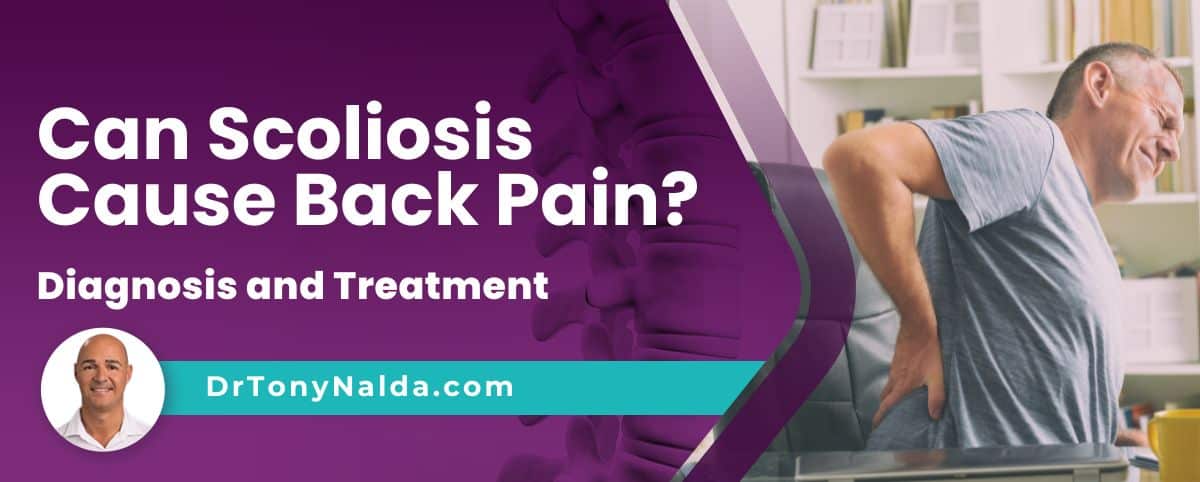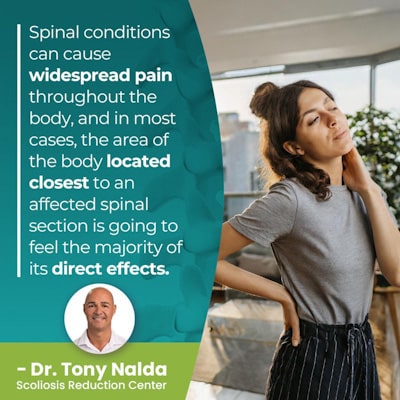Can Scoliosis Cause Back Pain? Diagnosis and Treatment

Scoliosis is a highly-variable condition that necessitates the complete customization of treatment plans. There are a number of patient and condition factors that shape a patient's experience of life with the condition, including whether or not it's painful; continue reading to learn more.
Scoliosis can cause back pain, pain that radiates into the extremities, and muscle pain. Patient age, condition type, severity, and curvature location shape how painful a patient's scoliosis is going to be. The best time to start scoliosis treatment is always now.
As a progressive condition, the nature of scoliosis is to get worse, so let's start with how the condition is first diagnosed.
Table of Contents
Diagnosing Scoliosis
Diagnosing scoliosis isn't always easy; when mild, its signs can be subtle and difficult for anyone, other than an expert, to notice.
In addition, there are a number of spinal conditions that cause a loss of healthy spinal curves, but scoliosis has some diagnostic parameters that set it apart from the rest.
In order to reach a diagnosis of scoliosis, a sideways curvature of the spine that also rotates has to be present, and the size of the unnatural spinal curve has to have a minimum Cobb angle measurement of at least 10 degrees.
A patient's Cobb angle is determined during X-ray, so in addition to a physical examination, a scoliosis X-ray is necessary to see what's happening in and around the spine, to confirm the rotational component, and to measure the Cobb angle.
Condition severity is determined by the Cobb angle, and this is a key piece of information that treatment plans are shaped around, along with the type of symptoms a patient is likely to experience.
So now that we know how scoliosis is diagnosed, let's discuss the nature of scoliosis pain and the patient/condition factors that shape it.
Patient Age and Back Pain
 In addition to condition severity and the angle of trunk rotation, patient age is a significant factor when it comes to the level of scoliosis pain a patient is going to experience.
In addition to condition severity and the angle of trunk rotation, patient age is a significant factor when it comes to the level of scoliosis pain a patient is going to experience.
As a structural spinal condition, scoliosis involves a structural abnormality within the spine itself, so a spine that's unnaturally bent and twisted sounds painful, doesn't it?
Surprisingly, not all scoliosis patients describe their conditions as painful; many don't experience back pain, and this is largely shaped by patient age and compression.
Scoliosis affects all ages, but it doesn't become a compressive condition until skeletal maturity has been reached, and it's compression of the spine and its surrounding muscles and nerves that causes the majority of condition-related pain.
In young patients who are still growing, their spines are experiencing a constant lengthening motion that counteracts the compressive force of the unnatural spinal curve; while young patients can experience muscle pain caused by the condition's uneven forces, back pain is less common in young patients than in adult scoliosis.
For adults, back pain, and pain that radiates into the extremities due to nerve compression, is the main effect that brings adults in for a diagnosis and treatment.
Patient age is also important in terms of progression; progression is triggered by growth, so as a child grows, and particularly during growth spurts, the condition becomes more severe.
So back pain caused by scoliosis is largely shaped by patient age and can involve pain caused by the structural changes within the spine itself, nerve pain felt throughout the body as the spinal nerves are exposed to uneven pressure, becoming irritated, inflamed, and/or impinged, and muscle pain caused by the spine's surrounding muscles being pulled in different directions as they struggle to support an unnaturally-curved spine.
Condition Type and Back Pain
In addition to scoliosis affecting all ages, there are also different condition types a patient can develop.
The most common type of scoliosis diagnosed is idiopathic scoliosis, meaning cause unknown; the most prevalent type of scoliosis overall is adolescent idiopathic scoliosis diagnosed between the ages of 10 and 18.
Remember, for children, the condition is not yet compressive, so in the majority of cases, back pain isn't a part of the scoliosis experience, in some cases, even when severe.
Approximately 80 percent of known cases are classified as idiopathic scoliosis, and the remaining 20 percent are associated with known causes and are considered atypical: neuromuscular scoliosis, degenerative scoliosis, and congenital scoliosis.
Typical cases of idiopathic scoliosis tend to be simpler to treat because they aren't caused by a more serious issue, but atypical cases with atypical causes tend to be more severe, and the more severe a condition is, the more likely it is to be painful and require pain relief.
Neuromuscular scoliosis, for example, is caused by a number of larger neuromuscular conditions, so the neuromuscular condition makes the scoliosis severe and the scoliotic curves tend to be more rigid and painful.
Degenerative scoliosis can be particularly painful also because it affects older adults for whom natural age-related spinal degeneration has caused the scoliosis to develop, making the spine increasingly unstable.
Congenital scoliosis isn't known as particularly painful because it affects babies born with the condition, and it won't become compressive until skeletal maturity has been reached.
Condition Severity and Back Pain
As mentioned earlier, condition severity is determined by a patient's Cobb angle, and this involves drawing lines from the tops and bottoms of the curve's most-tilted vertebrae, at its apex, and the resulting angle is expressed in degrees.
The higher a patient's Cobb angle, the further out of alignment the spine is, the more severe the condition, the more rotation there is, and the more painful it's likely to be:
- Mild scoliosis: Cobb angle measurement of between 10 and 25 degrees
- Moderate scoliosis: Cobb angle measurement of between 25 and 40 degrees
- Severe scoliosis: Cobb angle measurement of 40+ degrees
- Very-severe scoliosis: Cobb angle measurement of 80+ degrees
The more severe a condition, the more likely it is to cause noticeable levels of compression, in adult patients, so when it comes to back pain, condition severity is a crucial factor; the more unnaturally tilted the spine is, the more the spine, its surrounding muscles and nerves, and the entire body is being exposed to uneven forces and compression.
Curvature Location and Back Pain
 When it comes time to treat scoliosis and manage symptoms, curvature location is important.
When it comes time to treat scoliosis and manage symptoms, curvature location is important.
There are three main spinal sections, and scoliosis can develop in any one, or in more than one as a combined scoliosis: cervical spine (neck), thoracic spine (middle/upper back), and the lumbar spine (lower back).
Spinal conditions can cause widespread pain throughout the body, and in most cases, the area of the body located the closest to an affected spinal section is going to feel the majority of its direct effects.
For example, in cases of lumbar scoliosis that develop in the lower back where the sciatic nerve starts, sciatic nerve pain is a common complication.
The sciatic nerve starts in the lumbar spine and extends down the back of the hip, buttock, leg, into the foot, and is commonly felt down the left side of the body.
Sciatic nerve pain can feel like shooting sensations, electric shock-like pain, tingling and numbness, so low back pain and leg pain can be common effects of lumbar scoliosis.
Thoracic scoliosis is also associated with rib and chest pain because the thoracic vertebrae attach to the rib cage, so a common effect is the development of a rib cage arch that's caused by the ribs on one side protruding more on one side than the other, and this can cause varying levels of pain, particularly in adults for whom the condition is compressive.
Conclusion
When it comes to scoliosis back pain, the best remedy is proactive treatment that addresses the condition's underlying structural nature.
The effects of scoliosis will increase alongside progression, so if a patient's scoliosis is painful, it's likely to get more painful if left untreated, or not treated proactively.
Proactively treating scoliosis means starting treatment as close to the time of diagnosis as possible; while there are never treatment guarantees, with early detection and intervention, there are fewer limits to what can be achieved.
Here at the Scoliosis Reduction Center, patients benefit from a proactive conservative scoliosis treatment approach with proven results.
Conservatively treating scoliosis means working towards preventing progression, increasing condition effects, and the need for invasive spinal fusion surgery in the future.
Integrating multiple condition-specific treatment disciplines allows for the complete customization of treatment plans and combines the power of chiropractic care, physical therapy, corrective bracing, and rehabilitation.
The most important thing to know about scoliosis treatment is that regardless of type or severity, the sooner treatment is started, the better; it only gets more complex to treat the more it progresses.
If scoliosis is left untreated, it's virtually guaranteed to get worse and can cause severe back pain and potentially serious complications (breathing problems and digestive issues).
Dr. Tony Nalda
DOCTOR OF CHIROPRACTIC
After receiving an undergraduate degree in psychology and his Doctorate of Chiropractic from Life University, Dr. Nalda settled in Celebration, Florida and proceeded to build one of Central Florida’s most successful chiropractic clinics.
His experience with patients suffering from scoliosis, and the confusion and frustration they faced, led him to seek a specialty in scoliosis care. In 2006 he completed his Intensive Care Certification from CLEAR Institute, a leading scoliosis educational and certification center.
About Dr. Tony Nalda
 Ready to explore scoliosis treatment? Contact Us Now
Ready to explore scoliosis treatment? Contact Us Now





